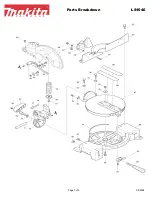
16
faces the rip fence holder according to your work as
shown in the figure.
Insert the square nut on the rip fence holder into the
back end of either slit of the rip fence so that they fit
as shown in the figure.
To change from the pattern A or B to the pattern C or D,
or in adverse case, remove the square nut and
clamping screw (A) from the rip fence holder, then
position the clamping screw (A) and square nut on the
opposite position of the rip fence holder compared to
the original position Tighten the clamping screw (A)
securely after inserting the square nut of the rip fence
holder into the rip fence slit.
Insert the square nut on the rip fence holder into the
back end of either slit of the rip fence so that they fit
as shown in the figure.
Fig.29
The rip fence is factory adjusted so that it is parallel to the
blade surface. Make sure that it is parallel. To check to be
sure that the rip fence is parallel with the blade, adjust the
blade height with the cutting depth adjusting knob so that
the blade appears at the topmost position from the table.
Mark one of the blade teeth with a crayon. Measure the
distance (A) and (B) between the rip fence and blade.
Take both measurements using the tooth marked with
the crayon. These two measurements should be identical
If the rip fence is not parallel with the blade, proceed as
follows:
Fig.30
(1) Turn the adjusting screw counterclockwise.
Fig.31
Fig.32
(2) Shift the front edge of the rip fence slightly to
right or left until it becomes parallel with the
blade.
(3) Tighten the adjusting screw on the rip fence
firmly.
CAUTION:
•
Be sure to adjust the rip fence so that it is parallel
with the blade, or a dangerous kickback condition
may occur.
•
Be sure to adjust the rip fence so that it does not
contact the top blade guard or saw blade.
•
Do not relocate or carry the tool by rip fence.
•
Raising the installed rip fence or exerting a force on
it to the right and left with your hand grabbing its top
end may damage it and impair its function.
Installing and adjusting miter gauge
Fig.33
Install the miter gauge by inserting its shaft into one of
two grooves in the table from the front. Miter gauge fence
that is also used as rip fence can be installed on the
miter gauge according to your work.
Dust bag
Fig.34
The use of the dust bag makes cutting operations clean
and dust collection easy. To attach the dust bag, fit it onto
the dust nozzle.
When the dust bag is about half full, remove the dust bag
from the tool and pull the fastener out. Empty the dust
bag of its contents, tapping it lightly so as to remove
particles adhering to the insides which might hamper
further collection.
Fig.35
If you connect a vacuum cleaner to your saw, more
efficient and cleaner operations can be performed.
Fig.36
Elbow
Fig.37
CAUTION:
•
Point the discharge opening of the elbow to the
direction in which the exhaust dust and chips do not
fly out toward the tool and persons in work area.
Attach the elbow when changing the direction of dust
discharge.
Securing workpiece
WARNING:
•
It is extremely important to always secure the
workpiece properly and tightly with the vise. Failure
to do so can cause the tool to be damaged and/or
the workpiece to be destroyed. PERSONAL
INJURY MAY ALSO RESULT. Also, after a cutting
operation, DO NOT raise the blade until the blade
has come to a complete stop.
Sub-fence
Fig.38
The sub-fence can be installed on the guide fence. When
performing left bevel cuts or cutting as table saw (bench
mode), remove the sub-fence.
CAUTION:
•
When performing left bevel cuts or cutting as table
saw (bench mode), remove the sub-fence.
Otherwise, it will contact the blade or a part of the
tool, causing possible serious injury to the operator.
Vertical vise
Fig.39
The vertical vise can be installed in two positions on
either the left or right side of the guide fence. Insert the
vise rod into the hole in the guide fence and tighten the
clamping screw to secure the vise rod.
Position the vise arm according to the thickness and
shape of the workpiece and secure the vise arm by
tightening the clamping screw. If the screw to secure the
vise arm contacts the guide fence, install the clamping
















































